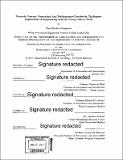Towards concept generation and performance-complexity tradespace exploration of engineering systems using convex hulls
Author(s)
Shougarian, Narek Rouben
DownloadFull printable version (59.49Mb)
Other Contributors
Massachusetts Institute of Technology. Department of Aeronautics and Astronautics.
Advisor
Olivier de Weck.
Terms of use
Metadata
Show full item recordAbstract
This thesis examines tradeoffs between performance and complexity in the context of future aircraft engine architectures and a reconfigurable mobile device. Traditionally aircraft/engine system architecture selection has been conducted via expert suggestion, evaluation and down-selection of alternatives. This work proposes a convex hull-based computational approach to generating architectures that uses flows at subsystem interfaces to enforce feasibility of connections between components. Convex hulls at component interfaces are used to represent the entire space of possible flows that they can exhibit. This is combined with automatic nonlinear model synthesis, optimization and complexity quantification to create an approach that allows the designer to trade the number of false negatives and the size of the design space. A false negative is an architecture that is not generated or once generated is discarded from consideration erroneously as an infeasible one, even though once implemented it would perform the intended function at the intended level of performance adequately. 71 aircraft engine architectures were generated and optimized for minimum uninstalled thrust specific fuel consumption, including families of distributed/non-distributed turboelectric architectures. Families of distributed turboelectric propulsion systems in which some fans are driven electrically and some are driven mechanically were found to exhibit lower uninstalled fuel consumption than current designs due to high efficiency & power to weight ratio of mechanical power transfer and the propulsive efficiency improvements despite losses in electrical power transfer. A simplified correction for the weight penalty associated with these architectures however shows that to gain overall benefit in fuel consumption, boundary layer ingestion will be required. While the literature typically examines individual concepts, in this case a portfolio of concepts was generated and can be leveraged in new aircraft configuration design studies in the future. The second major finding of this work is that the set of generated distributed turboelectric architectures are approximately 1.2 to 2 times as complex as current engine architectures using a complexity metric from the literature that takes into account complexity of components, interfaces and the network of connections between them. 21,168 reconfigurable mobile device architectures were generated and simulated. This number is larger than that for engines due to the presence of more optional components for the reconfigurable mobile device and the fact that this analysis was carried out at only one level abstraction, whereas two were used for the engine. The first finding was that only approximately 2% of possible architectures were feasible. The second finding was that, while no individual architecture was exceedingly complex compared to current devices, the aggregate complexity of the full set of 21,168 architectures was very high. Moreover, the sparse space of feasible architectures meant that in addition to conducting virtual/physical verification and validation of predicted feasible device configurations, a platform owner would have to guide users through a vast architectural space to their desired configuration.
Description
Thesis: Ph. D., Massachusetts Institute of Technology, Department of Aeronautics and Astronautics, 2017. Cataloged from PDF version of thesis. Includes bibliographical references (pages 239-249).
Date issued
2017Department
Massachusetts Institute of Technology. Department of Aeronautics and AstronauticsPublisher
Massachusetts Institute of Technology
Keywords
Aeronautics and Astronautics.